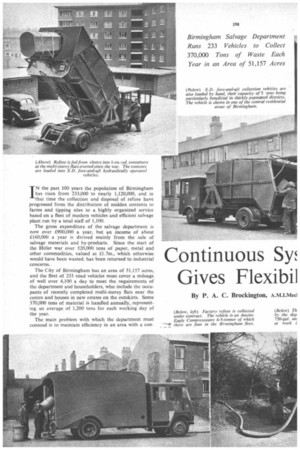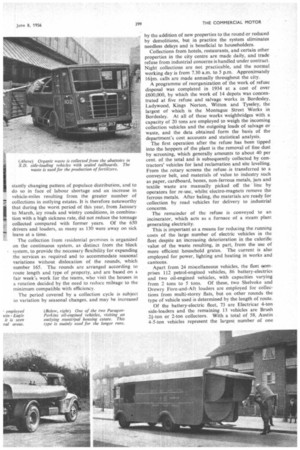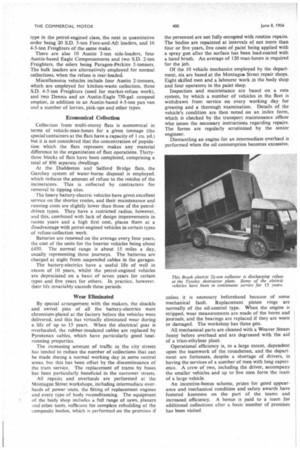Continuous Sr Gives Flexibil
Page 74

Page 75

Page 76

If you've noticed an error in this article please click here to report it so we can fix it.
By P. A. C. Brockington, IN the past 100 years the population of Birmingham has risen from 233,000 to nearly 1,120,000, and in that time the collection and disposal of refuse have progressed from the distribution of midden contents to farms and tipping sites to a highly organized service based on a fleet of modern vehicles and efficient salvage plant run by a total staff of 1,100.
The gross expenditure of the salvage department is now over £900,000 a year, but an income of about £160,000 a year is derived mainly from the sale of salvage materials and by-products. Since the start of the Hitler war over 520,000 tons of paper, metal and other commodities, valued at .£1.7m., which otherwise would have been wasted, has been returned to industrial concerns.
The City of Birmingham has an area of 51,157 acres, and the fleet of 233 road vehicles must cover a mileage of well over 4,100 a day to meet the requirements of the department and householders, who include the occupants of recently completed multi-storey flats near the centre and houses in new estates on the outskirts. Some 370,000 tons of material is handled annually, representing an average of 1,200 tons for each working day of the year.
The main problem with which the department must contend is to maintain efficiency in an area with a con stantly changing pattern of populace distribution, and to do so in face of labour shortage and an increase in vehicle-miles resulting from the greater number of collections in outlying estates. It is therefore noteworthy that during the worst period of this year, from January to March, icy roads and wintry conditions, in combination with a high sickness rate, did not reduce the tonnage collected compared with former years. Of the 650 drivers and loaders, as many as 130 were away on sick leave at a time.
The collection from residential premises is organized on the continuous system, as distinct from the block system, to provide the necessary flexibility for expanding the services as required and to accommodate seasonal variations without dislocation of the rounds, which number 165. The rounds are arranged according to route length and type of property, and are based on a fair week's work for the teams, who visit the houses in a rotation decided by the need to reduce mileage to the minimum compatible with efficiency.
The period covered by a collection cycle is subject to variation by seasonal changes, and may he increased by the addition of new properties to the round or reduced by demolitions, but in practice the system eliminates needless delays and is beneficial to householders.
Collections from hotels, restaurants, and certain other properties in the city centre are made daily, and trade refuse from industrial concerns is handled under contract. Night collections are not practicable, and the normal working day is from 7.30 a.m. to 5 p.m. Approximately 16im, calls are made annually throughout the city.
A programme of reorganization of the work of refuse disposal was completed in 1934 at a cast of over £600,000, by which the work of 14 depots was concentrated at five refuse and salvage works in Bordesley, Ladywood, Kings Norton, Witten and Tyseley, the largest of which •is the Montague Street Works in Bordesley. At all of these works weighbridges with a capacity of 20 tons are employed to weigh the incoming collection vehicles and the outgoing loads of salvage or waste, and the data obtained form the basis of the department's cost accounts and statistical analysis.
The first operation after the refuse has been tipped into the hoppers of the plant is the removal of fine dust by screening, which generally amounts to about 40 per cent, of the total and is subsequently collected by contractors' vehicles for land reclamation and site levelling. From the rotary screens the refuse is transferred to a conveyor belt, and materials of value to industry such as paper, cardboard, bones, non-ferrous metals, jars and textile waste are manually picked off the line by operators for re-use, whilst electro-magnets remove the ferrous metals. After baling, the materials are ready for collection by road vehicles for delivery to industrial concerns.
The remainder of the refuse is conveyed to an incinerator, which acts as a furnace of a steam plant generating electricity.
This is important as a means for reducing the running costs of the large number of electric vehicles in the fleet despite an increasing deterioration in the calorific value of the waste resulting, in part, from the use of more efficient household grates. The current is also employed for power, lighting and heating in works and canteens.
Apart from 24 miscellaneous vehicles, the fleet comprises 112 petrol-engined vehicles, 86 battery-electrics and two oil-engined vehicles, with capacities varying from 2 tons to 5 tons. Of these, two Shelvoke and Drewry Fore-and-Aft loaders are employed for collections from multi-storey flats, but on other rounds the type of vehicle used is determined by the length of route.
Of the battery-electric fleet, 73 are Electricar 4-ton side-loaders and the remaining 13 vehicles are Brush 2i-ton or 2-ton collectors. With a total of 58, Austin 4-5-ton vehicles represent the largest number of one type in the petrol-engined class, the next in quantitative order being 20 S.D. 5-ton Fore-and-Aft loaders, and 16 4-5-ton Freighters of the same make.
There are also 10 Austin 2-ton side-loaders, four Austin-based Eagle Compressmores and two S.D. 2-ton Freighters, the oilers being Paragon-Perkins 5-tonners, The hulk loaders are alternatively employed for normal collections, when the refuse is rear-loaded.
Miscellaneous vehicles include four Austin 2-tonners, which are employed for kitchen-waste collection, three S.D. 4-5-ton Freighters (used for market-refuse work), and two Dennis and an Austin-Eagle 750-gal. cesspool emptier, in addition to an Austin-based 4-5-ton pan van and a number of lorries, pick-ups and other types.
Economical Collection
Collection from multi-storey flats is economical in terms of vehicle-man-hours for a given tonnage (the special containers at the flats have a capacity of I cu. yd.) but it is not considered that the concentration of population which the flats represent makes any material difference to the organization of fleet operations. Thirtythree blocks of flats have been completed, comprising a total of 806 separate dwellings.
At the Duddeston and Salford Bridge flats, the Garchey system of water-borne disposal is employed. which reduces the amount of refuse to the residue of the incinerators. This is collected by contractors for removal to tipping sites.
The heavy battery-electric vehicles have given excellent service on the shorter routes, and their maintenance and running costs are slightly lower than those of the petroldriven types. They have a restricted radius, however, and this, combined with lack of design improvements in recent years and a high first cost, places them at a disadvantage with petrol-engined vehicles in certain types of refuse-collection work.
Batteries are renewed on the average every four years, the cost of the units for the heavier vehicles being about £450. The normal range is about 15 miles a day, usually representing three journeys. The batteries are charged at night from suspended cables in the garages.
The battery-eiectrics have a useful life of well in excess of 10 years, whilst the petrol-engined vehicles are depreciated on a basis of seven years for certain types and five years for others. In practice, however. their life invariably exceeds these periods.
Wear Eliminated
By special arrangement with the makers, the shackle and swivel pins of all the bartery-electrics were chromium-plated at the factory before the vehicles were delivered, and this has virtually eliminated wear during a life of up to 15 years. When the electrical gear is overhauled, the rubber-insulated cables are replaced by Pyrotenax cables, which have particularly good heatresisting properties.
The increasing amount of traffic in the city streets has tended to reduce the number of collections that can be made during a normal working day in some central areas, but this has been offset by the discontinuance of the tram service. The replacement of trams by buses has been particularly beneficial in the narrower streets.
All repairs and overhauls are performed at the Montague Street workshops, including intermediate overhauls of power units, the fitting of replacement engines and every type of body reconditioning. The equipment of the body shop includes a full range of saws, planers :ind other tools, sufficient for complete rebuilding of the composite bodies, which is performed on the premises if the personnel are not fully occupied with routine repairs. The bodies are repainted at intervals of not more than four or five years, five coats of paint being applied with a spray gun after the surface has been lead-coated with a hand brush. An average of 120 man-hours is required for the job.
Of the 10 vehicle mechanics employed by the department, six are based at the Montague Street repair shops. Eight skilled men and a labourer work in the body shop and four operators in the paint shop.
Inspection and maintenance are based on a rota system, by which a number of vehicles in the fleet is withdrawn from service on every working day for greasing and a thorough examination. Details of the vehicle's condition are then noted on an index form, which is checked by the transport maintenance officer who issues the necessary instructions regarding repairs. The forms are regularly scrutinized by the senior engineer.
Dismantling an engine for an intermediate overhaul is performed when the oil consumption becomes excessive.
unless it is necessary beforehand because of some mechanical fault. Replacement piston rings are normally of the oil-control type. When the engine is stripped, wear measurements are made of the bores and journals, and the bearings are replaced if they are worn or damaged. The workshop has three pits.
All mechanical parts are cleaned with a Weaver Steam Jenny before overhaul and are degreased with the aid of a trico-ethylene plant.
Operational efficiency is, to a large extent, dependent upon the teamwork of the roundsmen, and the department are fortunate, despite a shortage of drivers, in having the services of a number of men with long experience. A crew of two, including the driver, accompany the smaller vehicles and up to five men form the team of a large vehicle.
An incentive-bonus scheme, prizes for good appearance and mechanical condition and safety awards have fostered keenness on the part of the teams and increased efficiency. A bonus is paid to a team for additional collections after a basic number of premises has been visited.




















































































































































